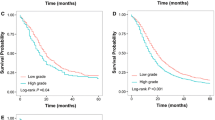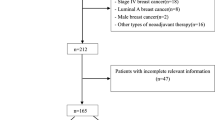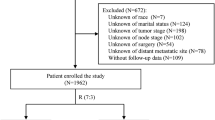Abstract
The purpose was to compare logistic regression model (LRM) and recursive partitioning (RP) to predict pathologic complete response to preoperative chemotherapy in patients with breast cancer. The two models were built in a same training set of 496 patients and validated in a same validation set of 337 patients. Model performance was quantified with respect to discrimination (evaluated by the areas under the receiver operating characteristics curves (AUC)) and calibration. In the training set, AUC were similar for LRM and RP models (0.77 (95% confidence interval, 0.74–0.80) and 0.75 (95% CI, 0.74–0.79), respectively) while LRM outperformed RP in the validation set (0.78 (95% CI, 0.74–0.82) versus 0.64 (95% CI, 0.60–0.67). LRM model also outperformed RP model in term of calibration. In these real datasets, LRM model outperformed RP model. It is therefore more suitable for clinical use.





Similar content being viewed by others
References
Chollet P, Amat S, Belembaogo E et al (2003) Is Nottingham prognostic index useful after induction chemotherapy in operable breast cancer? Br J Cancer 89:1185–1191. doi:10.1038/sj.bjc.6601258
Diblasio CJ, Kattan MW (2003) Use of nomograms to predict the risk of disease recurrence after definitive local therapy for prostate cancer. Urology 62(suppl 1):9–18. doi:10.1016/j.urology.2003.09.029
Eastham JA, Kattan MW, Scardino PT (2002) Nomograms as predictive models. Semin Urol Oncol 20:108–115. doi:10.1053/suro.2002.32936
Kattan MW (2003) Comparison of Cox regression with other methods for determining prediction models and nomograms. J Urol 170:S6–S9. doi:10.1097/01.ju.0000094764.56269.2d (discussion S10)
Kattan MW (2003) Nomograms are superior to staging and risk grouping systems for identifying high-risk patients: preoperative application in prostate cancer. Curr Opin Urol 13:111–116. doi:10.1097/00042307-200303000-00005
Kattan MW, Giri D, Panageas KS et al (2004) A tool for predicting breast carcinoma mortality in women who do not receive adjuvant therapy. Cancer 101:2509–2515. doi:10.1002/cncr.20635
Pusztai L, Gianni L (2004) Technology insight: Emerging techniques to predict response to preoperative chemotherapy in breast cancer. Nat Clin Pract Oncol 1:44–50. doi:10.1038/ncponc0025
Ravdin PM, Siminoff LA, Davis GJ et al (2001) Computer program to assist in making decisions about adjuvant therapy for women with early breast cancer. J Clin Oncol 19:980–991
Rouzier R, Pusztai L, Delaloge S et al (2005) Nomograms to predict pathologic complete response and metastasis-free survival after preoperative chemotherapy for breast cancer. J Clin Oncol 23:8331–8339. doi:10.1200/JCO.2005.01.2898
Rouzier R, Pusztai L, Garbay JR et al (2006) Development and validation of nomograms for predicting residual tumor size and the probability of successful conservative surgery with neoadjuvant chemotherapy for breast cancer. Cancer 107:1459–1466. doi:10.1002/cncr.22177
Shariat SF, Capitanio U, Jeldres C, Karakiewicz PI (2008) Can nomograms be superior to other prediction tools? BJU Int
Shariat SF, Karakiewicz PI, Suardi N, Kattan MW (2008) Comparison of nomograms with other methods for predicting outcomes in prostate cancer: a critical analysis of the literature. Clin Cancer Res 14:4400–4407. doi:10.1158/1078-0432.CCR-07-4713
Chun FK, Graefen M, Briganti A et al (2007) Initial biopsy outcome prediction–head-to-head comparison of a logistic regression-based nomogram versus artificial neural network. Eur Urol 51:1236–1240. doi:10.1016/j.eururo.2006.07.021(discussion 1241–1233)
Contesso G, Mouriesse H, Friedman S, Genin J, Sarrazin D, Rouesse J (1987) The importance of histologic grade in long-term prognosis of breast cancer: a study of 1,010 patients, uniformly treated at the Institut Gustave-Roussy. J Clin Oncol 5:1378–1386
Hanley JA, McNeil BJ (1982) The meaning and use of the area under a receiver operating characteristic (ROC) curve. Radiology 143:29–36
Author information
Authors and Affiliations
Corresponding author
Rights and permissions
About this article
Cite this article
Rouzier, R., Coutant, C., Lesieur, B. et al. Direct comparison of logistic regression and recursive partitioning to predict chemotherapy response of breast cancer based on clinical pathological variables. Breast Cancer Res Treat 117, 325–331 (2009). https://doi.org/10.1007/s10549-009-0308-2
Received:
Accepted:
Published:
Issue Date:
DOI: https://doi.org/10.1007/s10549-009-0308-2




